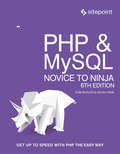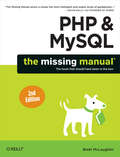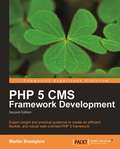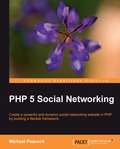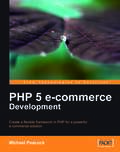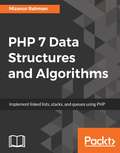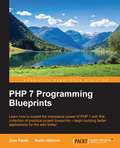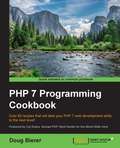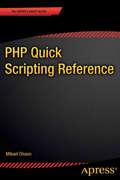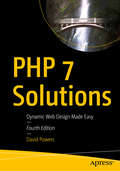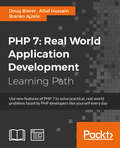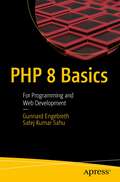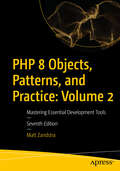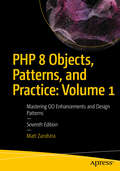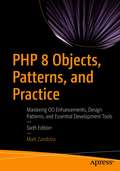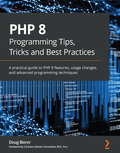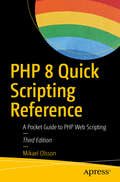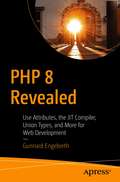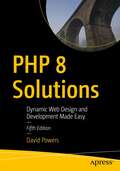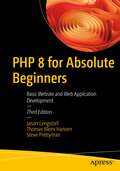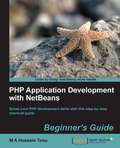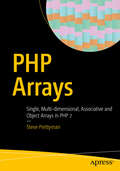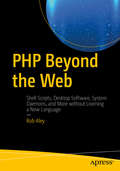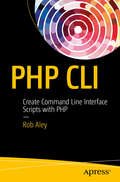- Table View
- List View
PHP & MySQL: Get Up to Speed With PHP the Easy Way
by Kevin Yank Tom ButlerPHP & MySQL: Novice to Ninja, 6th Edition is a hands-on guide to learning all the tools, principles, and techniques needed to build a fully functional application using PHP & MySQL. Comprehensively updated to cover PHP 7 and modern best practice, this practical and fun book covers everything from installing PHP and MySQL through to creating a complete online content management system. You'll learn how to: Install PHP & MySQL on Windows, Mac OS X, or LinuxGain a thorough understanding of PHP syntaxUse object oriented programming techniquesMaster database design principles and SQLDevelop robust websites that can handle high levels of trafficBuild a working content management system (CMS)And much more!
PHP & MySQL: The Missing Manual, Second Edition
by Brett McLaughlinIf you can build websites with CSS and JavaScript, this book takes you to the next level—creating dynamic, database-driven websites with PHP and MySQL. Learn how to build a database, manage your content, and interact with users. With step-by-step tutorials, this completely revised edition gets you started with expanded coverage of the basics and takes you deeper into the world of server-side programming.The important stuff you need to know:Get up to speed quickly. Learn how to install PHP and MySQL, and get them running on both your computer and a remote server.Gain new techniques. Take advantage of the all-new chapter on integrating PHP with HTML web pages.Manage your content. Use the file system to access user data, including images and other binary files.Make it dynamic. Create pages that change with each new viewing.Build a good database. Use MySQL to store user information and other data.Keep your site working. Master the tools for fixing things that go wrong.Control operations. Create an administrative interface to oversee your site.
PHP 5 CMS Framework Development - 2nd Edition
by Martin BramptonThe book includes extensive discussion of the design issues, and how to overcome them in the framework. Each chapter of the book focuses on a particular requirement of the framework. The book will not present the total code for a framework, which requires many thousands of lines. But it does show the parts that raise critical design or implementation issues. For these, detailed explanation is given, leaving the less problematic parts to the code download itself. If you are a professional PHP developer who wants to know more about web oriented frameworks and content management systems, this book is for you. Whether you already use an in-house developed framework or are developing one, or if you are simply interested in the issues involved in this demanding area, you will find discussion ranging from design issues to detailed coding solutions in this book. You are expected to have experience working with PHP 5 object-oriented programming. Examples in the book will run on any recent version of PHP 5, including 5.3.
PHP 5 Social Networking
by Michael PeacockThis book is a fast-paced tutorial focusing on creating a Social Networking framework through an ongoing case study. It presents a lot of real-world code, with comprehensive explanation and discussion. With each chapter, the Social Networking framework is extended, with more functionality being added as we progress through the book.This book is primarily aimed at PHP developers, but is suitable for any web developers looking to expand their knowledge and understanding of Social Networking concepts. Intermediate knowledge of PHP and object-oriented programming is assumed, along with a basic knowledge of MySQL.
PHP 5 e-commerce Development
by Michael PeacockThis is a fast-paced tutorial focusing on creating a framework and using it to build an online store through an ongoing case study. Later chapters include examples to illustrate how easily the framework can be adapted for different situations. The framework and code are enhanced and built upon with each chapter, adding more and more functionality. If you are a web developer, or anyone looking to increase your understanding of e-commerce site development, this book is for you. Primarily aimed at PHP developers, it is suitable for any web developer interested in enhancing their e-commerce knowledge, or developers looking to move towards PHP. Intermediate knowledge of PHP development and object-oriented programming is assumed, and basic knowledge of e-commerce principles will be of benefit too.
PHP 7 Data Structures and Algorithms
by Mizanur RahmanIncrease your productivity by implementing data structures About This Book • Gain a complete understanding of data structures using a simple approach • Analyze algorithms and learn when you should apply each solution • Explore the true potential of functional data structures Who This Book Is For This book is for those who want to learn data structures and algorithms with PHP for better control over application-solution, efficiency, and optimization. A basic understanding of PHP data types, control structures, and other basic features is required What You Will Learn • Gain a better understanding of PHP arrays as a basic data structure and their hidden power • Grasp how to analyze algorithms and the Big O Notation • Implement linked lists, double linked lists, stack, queues, and priority queues using PHP • Work with sorting, searching, and recursive algorithms • Make use of greedy, dynamic, and pattern matching algorithms • Implement tree, heaps, and graph algorithms • Apply PHP functional data structures and built-in data structures and algorithms In Detail PHP has always been the the go-to language for web based application development, but there are materials and resources you can refer to to see how it works. Data structures and algorithms help you to code and execute them effectively, cutting down on processing time significantly. If you want to explore data structures and algorithms in a practical way with real-life projects, then this book is for you. The book begins by introducing you to data structures and algorithms and how to solve a problem from beginning to end using them. Once you are well aware of the basics, it covers the core aspects like arrays, listed lists, stacks and queues. It will take you through several methods of finding efficient algorithms and show you which ones you should implement in each scenario. In addition to this, you will explore the possibilities of functional data structures using PHP and go through advanced algorithms and graphs as well as dynamic programming. By the end, you will be confident enough to tackle both basic and advanced data structures, understand how they work, and know when to use them in your day-to-day work Style and approach An easy-to-follow guide full of examples of implementation of data structures and real world examples to solve the problems faced. Each topic is first explained in general terms and then implemented using step by step explanation so that developers can understand each part of the discussion without any problem.
PHP 7 Programming Blueprints
by Jose Palala Martin HelmichLearn how to exploit the impressive power of PHP 7 with this collection of practical project blueprints - begin building better applications for the web today! About This Book * Don't just learn PHP 7 - follow a diverse range of practical knowledge to get started quickly * Take advantage of PHP 7's newest features - and find out how to use them to solve real development challenges * Put PHP to work for performance and scalability - we'll show you how, you do it! Who This Book Is For The book is for web developers, PHP consultants, and anyone who is working on multiple projects with PHP. Basic knowledge of PHP programming is assumed. What You Will Learn * Build versatile projects using the newest features PHP 7 has to offer * Learn how to use PHP 7's event-driven asynchronous features * Find out how to improve the performance of your code with effective techniques and design patterns * Get to grips with backend development and find out how to optimize session handling * Learn how to use the PHP 7 Abstract Syntax Tree to improve the quality of your code and make it more maintainable * Find out how to build a RESTful web service * Build your own asynchronous microservice In Detail When it comes to modern web development, performance is everything. The latest version of PHP has been improvised and updated to make it easier to build for performance, improved engine execution, better memory usage, and a new and extended set of tools. If you're a web developer, what's not to love? This guide will show you how to make full use of PHP 7 with a range of practical projects that will not only teach you the principles, but also show you how to put them into practice. It will push and extend your skills, helping you to become a more confident and fluent PHP developer. You'll find out how to build a social newsletter service, a simple blog with a search capability using Elasticsearch, as well as a chat application. We'll also show you how to create a RESTful web service, a database class to manage a shopping cart on an e-commerce site and how to build an asynchronous microservice architecture. With further guidance on using reactive extensions in PHP, we're sure that you'll find everything you need to take full advantage of PHP 7. So dive in now! Style and approach This product focuses on helping developers build projects from scratch. But more than that, each project will help the reader to learn a new facet or feature of PHP 7 - it means the reader really will 'learn by doing.'
PHP 7 Programming Cookbook
by Doug BiererOver 80 recipes that will take your PHP 7 web development skills to the next level! About This Book * This is the most up-to-date book in the market on PHP * It covers the new features of version 7.x, best practices for server-side programming, and MVC frameworks * The recipe-based approach will allow you to explore the unique capabilities that PHP offers to web programmers Who This Book Is For If you are an aspiring web developer, mobile developer, or backend programmer, then this book is for you as it will take your PHP programming skills to next level. Basic knowledge of PHP programming is assumed. What You Will Learn * Use advanced PHP 7 features, such as the Abstract Syntax Tree, Uniform Variable Syntax, Scalar Type Hints, Generator Delegation, Anonymous Classes, and the Context Sensitive Lexer * Discover where and when PHP 5 code needs to be re-written to avoid backwards-compatibility breaks * Improve the overall application security and error handling by taking advantage of classes that implement the new throwable interface * Solve practical real-world programming problems using PHP 7 * Develop middle-wareclasses that allow PHP developers to gluedifferent open source libraries together seamlessly * Define and Implement PSR-7 classes * Create custom middleware using PSR-7 compliant classes * Test and debug your code, and get to know the best practices In Detail PHP 7 comes with a myriad of new features and great tools to optimize your code and make your code perform faster than in previous versions. Most importantly, it allows you to maintain high traffic on your websites with low-cost hardware and servers through a multithreading web server. This book demonstrates intermediate to advanced PHP techniques with a focus on PHP 7. Each recipe is designed to solve practical, real-world problems faced by PHP developers like yourself every day. We also cover new ways of writing PHP code made possible only in version 7. In addition, we discuss backward-compatibility breaks and give you plenty of guidance on when and where PHP 5 code needs to be changed to produce the correct results when running under PHP 7. This book also incorporates the latest PHP 7.x features. By the end of the book, you will be equipped with the tools and skills required to deliver efficient applications for your websites and enterprises. Style and approach This book takes a recipe-based approach, with real-world examples that can serve as building blocks for a larger application. Each recipe is self-contained with no external dependencies. This book follows a problem-solution strategy so you understand how to deal with various scenarios you may encounter while using PHP 7 in your daily activities.
PHP 7 Quick Scripting Reference
by Mikael OlssonThis pocket reference guide has been updated with the new PHP 7. 0 release. It is a condensed, code-rich scripting and syntax handbook for the PHP scripting language. PHP 7 Quick Scripting Reference presents the essential PHP syntax in a well-organized format. You won't find any technical jargon, bloated samples, drawn out history lessons or witty stories in this book. What you will find is a Web scripting language reference that is concise, to the point and highly accessible. The book is packed with useful information and is a must-have for any PHP programmer or Web developer. In it, you will find a concise reference to the PHP 7 scripting language syntax. It includes short, simple and focused code examples and a well laid out table of contents and a comprehensive index allowing easy review. What you'll learn What is new in PHP 7 and how to get started with it What are variables, operators, strings, arrays, conditionals, loops and other language constructs How to group and reuse code with functions, methods and namespaces How to use object-oriented features such as classes, inheritance, abstract classes and interfaces How to import files and retrieve user data What are type declarations and type conversions How to test variables, create references and use overloading methods How to store user data with cookies and sessions How to deal with errors through error handling, exception handling and assertions Who this book is for This book is a handy, pocket quick scripting syntax reference for experienced PHP as well as perhaps other programmers and Web developers even new to PHP.
PHP 7 Solutions: Dynamic Web Design Made Easy
by David PowersMake your websites more dynamic by adding a feedback form, creating a private area where members can upload images that are automatically resized, or perhaps storing all your content in a database. David Powers has updated his definitive book to incorporate the latest techniques and changes to PHP, including the arrival of PHP 7. New features include the spaceship and null coalesce operators, generators, using array shorthand syntax for list(), array dereferencing, and array unpacking with the splat operator.The problem is, you're not a programmer and the thought of writing code sends a chill up your spine. Or maybe you've dabbled a bit in PHP and MySQL, but you can't get past baby steps. If this describes you, then you've just found the right book. PHP and the MySQL database are deservedly the most popular combination for creating dynamic websites. They're free, easy to use, and provided by many web hosting companies in their standard packages. This book also covers MariaDB, a seamless replacement for MySQL that has been adopted on many web servers.Unfortunately, most PHP books either expect you to be an expert already or force you to go through endless exercises of little practical value. In contrast, this book gives you real value right away through a series of practical examples that you can incorporate directly into your sites, optimizing performance and adding functionality such as file uploading, email feedback forms, image galleries, content management systems, and much more. Each solution is created with not only functionality in mind, but also visual design.But this book doesn't just provide a collection of ready-made scripts: each PHP solution builds on what's gone before, teaching you the basics of PHP and database design quickly and painlessly. By the end of the book, you'll have the confidence to start writing your own scripts or—if you prefer to leave that task to others—to adapt existing scripts to your own requirements. Right from the start, you're shown how easy it is to protect your sites by adopting secure coding practices.What You Will LearnDesign and build dynamic PHP-based web sites and applications Get started right away through practical examples that you can reuseIncorporate PHP 7 elements including new ways of handling arrays Work with the latest PHP 7 techniques, innovations, and best practicesWho This Book Is ForReaders should have at least some prior exposure to web development using PHP.
PHP 7: Real World Application Development
by Branko Ajzele Altaf Hussain Doug BiererUse new features of PHP 7 to solve practical, real-world problems faced by PHP developers like yourself every day. About This Book * This course covers the new features of version 7.x, best practices for server-side programming, and MVC frameworks * Leverage the potential of PHP for server-side programming, memory management, and Object-Oriented Programming to improve your programming productivity * This course also illustrates the development of a complete modular application using PHP 7 in detail Who This Book Is For If you are an aspiring web developer, mobile developer, or back-end programmer, who has basic experience in PHP programming and wants to develop performance-critical applications, then this course is for you. It will take your PHP programming skills to next level. What You Will Learn * Solve practical real-world programming problems using PHP 7 * Discover where and when PHP 5 code needs to be re-written to avoid backwards-compatibility breaks * Use advanced PHP 7 features such as the Abstract Syntax Tree, Uniform Variable Syntax, Scalar Type Hints, Generator Delegation, Anonymous Classes, and the Context Sensitive Lexer * Set up a high performance development and production environment for PHP 7 * Discover new OOP features in PHP 7 to achieve high performance * Discover the new features of PHP 7 that are relevant to modular application development * Explore the ins and outs of the Symfony framework * Build a set of modules based on the Symfony framework that comprise a simple web shop app In Detail PHP is a great language for developing web applications. It is essentially a server-side scripting language. PHP 7 is the latest version, providing major backward-compatibility breaks and focusing on improved performance and speed. This course follows a learning path which is divided into three modules. Each module is a mini course in its own right, taking your basic PHP programing skills to the next level by showing you intermediate to advanced PHP techniques with a focus on PHP 7. This way, get you equipped with the tools and skills required to develop professional and efficient applications for your websites and enterprises. The first module of the book is a programming cookbook that consists over 80 recipes! Each recipe is designed to solve practical, real-world problems faced by PHP developers like yourself every day. This course also covers new ways of writing PHP code made possible only in version 7. The second module of the course is designed to improve the performance and productivity of your application. We'll introduce you to the concepts of Object-Oriented Programming (OOP) in PHP 7, then shed some light on how to improve the performance of your PHP 7 applications and database. Throughout this module you will be introduced to benchmarking tools. With all important concepts of PHP covered up you will move on to third module. In this module you will gain a deep insight into the modular programming paradigm and how to achieve modularity in your PHP code. Modular design techniques help you build readable, manageable, reusable, and more efficient codes. PHP 7, which is a popular open source scripting language, is used to build modular functions for your software. This Learning Path combines some of the best that Packt has to offer in one complete, curated package. It includes content from the following Packt products: * PHP 7 Programming Cookbook, Doug Bierer * Learning PHP 7 High Performance, Altaf Hussain * Modular Programming with PHP 7, Branko Ajzele Style and approach This book takes a practical, step-by-step approach with real-world examples that serve as building blocks for your application development and guide you through improving the quality of your code.
PHP 8 Basics: For Programming and Web Development
by Gunnard Engebreth Satej Kumar SahuTake advantage of PHP 8's powerful features to create basic web applications, solve code tests (required for most job interviews nowadays), and begin moving towards more advanced PHP concepts. This book provides an introduction to PHP 8, including modules, attributes, JIT compiler, and union types, as well as related frameworks such as Symfony.You will explore fundamental PHP concepts through both practical and hands-on examples. You'll not only gain a solid understanding of PHP fundamentals, but will also be prepared to handle new concepts and technologies as they emerge.After working through the book and its associated demo code, you will be able to build your first basic web application.What You Will LearnDevelop web applications with PHP 8Use Vagrant, Docker, JSON API and moreWork with data, form data, arrays, objections, exceptions, regex, and moreUtilize PHP frameworks like Laravel and SymfonyWho This Book Is ForThose new to PHP 8 or PHP in general. Some prior experience in web development and DB handling is recommended.
PHP 8 Objects, Patterns, and Practice: Mastering Essential Development Tools
by Matt ZandstraContinue to develop elegant and rock-solid systems using PHP. With a focus on mastering essential development tools and applying best practices, Volume 2 of this 7th edition has been fully updated for PHP 8.3 and the most recent stable iterations of all tools and processes. It includes entirely new chapters covering Docker, Ansible, refactoring tools, and PHP on the command line. The volume also reintroduces a chapter on inline documentation and extends its coverage of continuous integration to include GitHub Actions. This book builds on the solid grounding provided by Volume 1 to cover the tools and practices needed to develop, test, and deploy robust code. You’ll see how to manage multiple developers and releases with git, create development environments, and deploy Composer to leverage thousands of tools and libraries and manage dependencies. You’ll also explore strategies for automated testing and continuous integration and learn essential techniques for deploying your code using Git and Ansible. After reading and using this book, you will have mastered a toolset that can support the entire lifecycle of a PHP project, from the creation of a flexible development environment, through collaboration, the use of standards-based best practice and documentation, to testing and deployment across multiple production servers. You Will Learn To: Master the tools and strategies for testing new code, and techniques for testing legacy projects Create inline documentation for use by team members, users, and tools such as IDEs Work with Selenium to test web interfaces Manage your code and collaborate with your team using Git Leverage continuous integration to build rock solid systems Deploy your system and securely manage your project’s configuration with Ansible Who This Book Is For Anyone with at least a basic knowledge of PHP who wants to learn about the practices and tools) that can make projects safe, elegant and stable.
PHP 8 Objects, Patterns, and Practice: Mastering OO Enhancements and Design Patterns
by Matt ZandstraDevelop elegant and rock-solid systems using PHP, aided by three key elements: object fundamentals, design principles, and best practices. Now in its 7th edition, this book has been fully updated for PHP 8.3 and split into two volumes to better accommodate its wealth of new content. Volume 1 covers objects and patterns, while Volume 2 focuses on tools and best practices. You’ll begin this volume by reviewing PHP's object-oriented features including key topics such as class declarations, inheritance, and reflection. The second part of the book is devoted to design patterns. It explains the principles that make patterns powerful and covers many of the classic design patterns, as well as enterprise and database patterns. This volume provides a solid grounding in PHP's support for objects and builds on this foundation to apply the core principles of software design. New topics covered include read only classes, enumerations, typed class constants, as well as various additions to argument and return types. The knowledge gained from this book will help you master the object-oriented enhancements and the design patterns available for PHP 8, paving the way for developing best practices in Volume 2. What You Will Learn Work with object fundamentals. Write classes and methods, instantiate objects, and create powerful class hierarchies using inheritance. Master advanced object-oriented features, including static methods and properties. Manage error conditions with exceptions and create abstract classes and interfaces. Use design principles to deploy objects and classes effectively in your projects. Discover a set of powerful patterns that you can implement in your own projects. Who This Book Is For Anyone with at least a basic knowledge of PHP who wants to use its object-oriented features in their projects.
PHP 8 Objects, Patterns, and Practice: Mastering OO Enhancements, Design Patterns, and Essential Development Tools
by Matt ZandstraLearn how to develop elegant and rock-solid systems using PHP, aided by three key elements: object fundamentals, design principles, and best practices. The 6th edition of this popular book has been fully updated for PHP 8, including attributes, constructor property promotion, new argument and return pseudo-types, and more. It also covers many features new since the last edition including typed properties, the null coalescing operator, and void return types. This book provides a solid grounding in PHP's support for objects, it builds on this foundation to instill core principles of software design and then covers the tools and practices needed to develop, test, and deploy robust code. PHP 8 Objects, Patterns, and Practice begins by covering PHP's object-oriented features. It introduces key topics including class declarations, inheritance, and reflection. The next section is devoted to design patterns. It explains the principles that make patterns powerful. You’ll cover many of the classic design patterns including enterprise and database patterns. The last segment of the book covers the tools and practices that can help turn great code into a successful project. The section shows how to manage multiple developers and releases with git, and how to manage builds and dependencies with Composer. It also explores strategies for automated testing and continuous integration. After reading and using this book, you will have mastered object-oriented enhancements, design patterns, and the essential development tools available for PHP 8. What You Will Learn Work with object fundamentals: write classes and methods, instantiate objects, and create powerful class hierarchies using inheritance Master advanced object-oriented features, including static methods and properties, managing error conditions with exceptions, and creating abstract classes and interfaces Understand and use design principles to deploy objects and classes effectively in your projects Discover a set of powerful patterns that you can implement in your own projects Guarantee a successful project including unit testing; version control and build, installation, and package management; and continuous integration Who This Book Is For Anyone with at least a basic knowledge of PHP who wants to use its object-oriented features in their projects. It is also for PHP coders who want to learn about the practices and tools (version control, testing, continuous integration, etc) that can make projects safe, elegant and stable.
PHP 8 Programming Tips, Tricks and Best Practices: A practical guide to PHP 8 features, usage changes, and advanced programming techniques
by Doug Bierer Cal EvansDiscover effective techniques, workarounds, and expert guidance for avoiding situations where your application might break following PHP 8 migrationKey FeaturesGet the hang of all the new features introduced in PHP 8Learn how to detect potential code breaks and keep your application code running smoothly in PHP 8Explore an exciting new trend - asynchronous PHP programming using Swoole and FibersBook DescriptionThanks to its ease of use, PHP is a highly popular programming language used on over 78% of all web servers connected to the Internet. PHP 8 Programming Tips, Tricks, and Best Practices will help you to get up-to-speed with PHP 8 quickly. The book is intended for any PHP developer who wants to become familiar with the cool new features available in PHP 8, and covers areas where developers might experience backward compatibility issues with their existing code after a PHP 8 update. The book thoroughly explores best practices, and highlights ways in which PHP 8 enforces these practices in a much more rigorous fashion than its earlier versions.You'll start by exploring new PHP 8 features in the area of object-oriented programming (OOP), followed by enhancements at the procedural level. You'll then learn about potential backward compatible breaks and discover best practices for improving performance. The last chapter of the book gives you insights into PHP async, a revolutionary new way of programming, by providing detailed coverage and examples of asynchronous programming using the Swoole extension and Fibers.By the end of this PHP book, you'll not only have mastered the new features, but you'll also know exactly what to watch out for when migrating older PHP applications to PHP 8.What you will learnGain a comprehensive understanding of the new PHP 8 object-oriented featuresDiscover new PHP 8 procedural programming enhancementsUnderstand improvements in error handling in PHP 8Identify potential backward compatibility issuesAvoid traps due to changes in PHP extensionsFind out which features have been deprecated and/or removed in PHP 8Become well-versed with programming best practices enforced by PHP 8Who this book is forThis book is for PHP developers at all levels who have experience in PHP 5 or above. If you're just getting started with PHP, you'll find the code examples useful for learning the language. Developers who have worked for a few months on one or more PHP projects will be able to apply the tips and techniques to the code at hand, while those with many years of PHP experience are sure to appreciate the concise coverage of new PHP 8 features.
PHP 8 Quick Scripting Reference: A Pocket Guide to PHP Web Scripting
by Mikael OlssonThis pocket reference has been updated with the new PHP 8 release. It is a condensed, code-rich scripting and syntax handbook for the PHP scripting language. You won’t find any technical jargon, bloated samples, drawn-out history lessons or witty stories in this book. What you will find is a web scripting language reference that is concise, to the point, and highly accessible. The book is packed with useful information and is a must-have for any PHP programmer or web developer. In it, you will find a concise reference to the PHP 8 scripting language syntax. It includes short, simple, and focused code examples; a well-laid-out table of contents; and a comprehensive index allowing easy review. PHP 8 Quick Scripting Reference presents the essentials of PHP in a well-organized format, including new features in PHP 8 such as the just in time (JIT) compiler, union types, nullsafe operator, null coalescing assignment operator, match expressions, named arguments, throw expressions, static return type, non-capturing catches, reclassified engine warnings and constructor property promotion. What You Will Learn Discover what is new in PHP 8 and how to get started with it Work with variables, operators, strings, arrays, conditionals, loops, and other constructs Group and reuse code with functions, methods, and namespaces Use object-oriented features such as classes, inheritance, abstract classes, and interfaces Import files and retrieve user data Make use of type declarations and type conversions Test variables, create references, and use overloading methods Store user data with cookies and sessions Deal with errors through error handling, exception handling, and assertions Who This Book Is For Experienced PHP programmers and web developers who may be new to PHP.
PHP 8 Revealed: Use Attributes, the JIT Compiler, Union Types, and More for Web Development
by Gunnard EngebrethDiscover the new and updated features of PHP 8, such as the JIT compiler, union types, and attributes, with code examples of each. For each feature, the author includes real-life cases for its use and explains its benefits. What You Will LearnUtilize the new features of PHP 8 and modern development technologiesWork with the JIT compiler in PHP 8Discover PHP 8 using real-life casesIncrease your available resources to become more valuable in your development team Who This Book Is For Experienced PHP programmers new to PHP 8.
PHP 8 Solutions: Dynamic Web Design and Development Made Easy
by David PowersMake your websites more dynamic by adding a feedback form, creating a private area where members can upload images that are automatically resized, or storing all your content in a database. David Powers has updated his definitive book to incorporate the latest techniques and changes to PHP with the arrival of PHP 8. New features include named attributes, constructor property promotion, the stricter and more concise match expression, union types, and more. The problem is, you're not a programmer and the thought of writing code sends a chill up your spine. Or maybe you've dabbled a bit in PHP and MySQL, but you can't get past baby steps. If this describes you, then you've just found the right book. PHP powers four out of every five websites that use a server-side language. In combination with the MySQL database it’s ideal for creating dynamic websites. PHP and MySQL are free, easy to use, and provided by many web hosting companies in their standard packages. This book also covers MariaDB, a seamless replacement for MySQL that has been adopted on many web servers. Unfortunately, most PHP books either expect you to be an expert already or force you to go through endless exercises of little practical value. In contrast, this book gives you real value right away through a series of practical examples that you can incorporate directly into your sites, optimizing performance and adding functionality such as file uploading, email feedback forms, image galleries, content management systems, and much more. Each solution is created with not only functionality in mind, but also visual design. But this book doesn't just provide a collection of ready-made scripts: each PHP solution builds on what's gone before, teaching you the basics of PHP and database design quickly and painlessly. You’ll learn how to optimize your code using object-oriented programming (OOP) techniques. By the end of the book, you'll have the confidence to start writing your own scripts or—if you prefer to leave that task to others—to adapt existing scripts to your own requirements. Right from the start, you're shown how easy it is to protect your sites by adopting secure coding practices. What You Will Learn Design and build dynamic PHP-based web sites and applications Get started right away through practical examples that you can reuseIncorporate PHP 8 elements including named attributes, constructor property promotion, and union typesUnderstand the subtle, but important differences between switch and matchWork with the latest PHP 8 techniques, innovations, and best practices Who This Book Is For Readers should ideally have some prior exposure to web development using PHP.
PHP 8 for Absolute Beginners: Basic Website and Web Application Development
by Jason Lengstorf Steve Prettyman Thomas Blom HansenEmbark on a practical journey of building dynamic sites aided by multiple projects that can be easily adapted to real-world scenarios. This third edition will show you how to become a confident PHP developer, ready to take the next steps to being a Full Stack Developer and/or successful website or web application programmer. You won't be swamped with every detail of the full PHP language up front – instead, you’ll be introduced to a small, versatile subset of PHP by learning to use it creatively to develop dynamic projects. You will see how to use variables, control structures, functions, and object-oriented programming. Secure programming techniques are used throughout the book to demonstrate the proper way to defend against hackers. You will learn how to plan and create MySQL/MariaDB databases and access them using PHP. During this process, you will be introduced to data objects, UI design concepts, and design patterns. Model-View-Controller (MVC) methodology will be used to keep a consistent logical design for each project. Four main projects will be introduced: an image gallery, a blogging system, a data management dashboard, and an interactive game. Initially, a general discussion of how operating systems make programming easier, more reliable, and efficient will be provided. A brief example will follow to demonstrate installation of the latest versions of Apache, PHP, and MySQL/MariaDB. Basic PHP logic will be used during the development of the first project, an image gallery. Once these concepts have been absorbed, a further review of additional concepts of PHP 8 will be discussed, followed by an extensive blogging system will use MVC to reinforce and introduce additional PHP techniques. You’ll also discover the use of Google Charts to create a data management dashboard. Finally, you’ll explore arrays in more depth by developing logic for a checkers game. Along the way, exercises and projects are provided to reinforce what has been learned. What You'll Learn Explore the basics of PHP syntax, structures, functions, modules and more Design and develop of interactive UIs Build dynamic UIs using SQL to access MySQL/MariaDB Databases Understand the development of secure and efficient Object-Oriented classes and objects Apply the knowledge learned when creating four real-world PHP projects Who This Book Is For Aspiring web developers and designers who are new to web development and/or PHP; programmers who are new to PHP and even programming itself.
PHP Ajax Cookbook
by Milan Sedliak R. Rajesh AnbiahThis book contains a collection of recipes with step-by-step directions to build SEO-friendly websites using standard Ajax tools. Each recipe contains behind-the-scene explanations to PHP Ajax questions. This book is an ideal resource for people who like to add Ajax features to websites and who prefer standards and best practices for building SEO-friendly websites. As the book covers advanced topics, readers need to be aware of basic PHP, JavaScript and XML features.
PHP Application Development with NetBeans: Beginner's Guide
by M A TonuA Beginner's Guide The book is aimed at PHP developers who wish to develop PHP applications while taking advantage of NetBeans functionality to ease their software development efforts and utilize the powerful features of the IDE. Familiarity with NetBeans is not assumed. However, a little familiarity with PHP development is expected.
PHP Arrays
by Steve PrettymanGain an in-depth understanding of PHP 7 arrays. After a quick overview of PHP 7, each chapter concentrates on single, multi-dimensional, associative, and object arrays. PHP Arrays is a first of its kind book using PHP 7 that demonstrates inserting, appending, updating, and deleting array data. This book also covers validation methods to insure that the data provided by a user is good before the data is entered into an array. You'll see how PHP 7 try/catch modules are used to capture exceptions and errors that may be caused by invalid data. The code examples demonstrate common real-world scenarios. Moreover, examples of every PHP 7 array function (over 75) are demonstrated. The appendix provides a two-dimensional array case study on the logical design of a checkers game. PHP Arrays answers the following questions: Why do we need arrays? When do we need to use arrays? Are arrays efficient? Can arrays reduce coding time? When do you use multi-dimensional and associative arrays? What is an object array? What You'll Learn Handle array data from an HTML form Manage array data from a text file Deal with array data from a MySQL database Who This Book Is For Experienced PHP programmers or web developers using PHP.
PHP Beyond the Web
by Rob AleyUse your existing web-based PHP skills to write all types of software: CLI scripts, desktop software, network servers, and more. This book gives you the tools, techniques, and background necessary to write just about any type of software you can think of, using the PHP you know.PHP Beyond the Web shows you how to take your knowledge of PHP development for the web and utilise it with a much wider range of software systems. Enjoy the benefits of PHP after reading this book: save money by redeploying existing skills, not learning new ones; save time and increase productivity by using a high-level language; and make money by providing your clients a full-stack service (not just websites).PHP is no longer just a great scripting language for websites, it's now a powerful general-purpose programming language. Expand your use of PHP into your back-end systems, server software, data processing services, desktop interfaces, and more. What You'll LearnWrite interactive shell scriptsWork with system daemonsWrite desktop softwareBuild network serversInterface with electronics using PHP and the Raspberry PiManage performance, deployment, licensing, and system interactionDiscover the software tools for development and get other great sources of technical information and helpWho This Book Is ForExperienced PHP programmers or experienced programmers interested in leveraging PHP outside the web development context.
PHP CLI
by Rob AleyThis concise book shows you how to create PHP command line interface (CLI) scripts, including user interaction and scripts to automate and assist your workflow. Learn to quickly create useful and effective command line software and scripts using the world's most popular web scripting language, PHP. Enjoy the benefits of writing CLI scripts in PHP: save money by redeploying existing skills, not learning new ones. Save time and increase productivity by using a high-level language. Make money by providing your clients with a full-stack service.What You'll LearnLearn about the PHP CLI SAPIFind out how to use it to run PHP scripts off-lineEasily deal with user input and console outputWork with helper libraries and softwareFind out the differences between programming for the web and for the CLIWho This Book Is ForExperienced PHP programmers and web developers.
